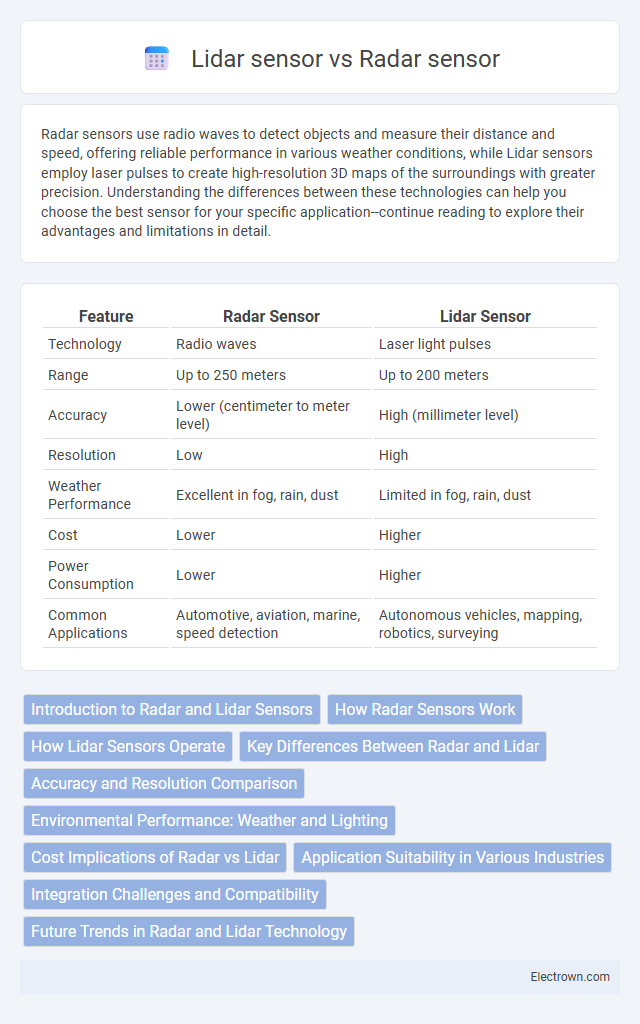Radar sensors use radio waves to detect objects and measure their distance and speed, offering reliable performance in various weather conditions, while Lidar sensors employ laser pulses to create high-resolution 3D maps of the surroundings with greater precision. Understanding the differences between these technologies can help you choose the best sensor for your specific application--continue reading to explore their advantages and limitations in detail.
Table of Comparison
| Feature | Radar Sensor | Lidar Sensor |
|---|---|---|
| Technology | Radio waves | Laser light pulses |
| Range | Up to 250 meters | Up to 200 meters |
| Accuracy | Lower (centimeter to meter level) | High (millimeter level) |
| Resolution | Low | High |
| Weather Performance | Excellent in fog, rain, dust | Limited in fog, rain, dust |
| Cost | Lower | Higher |
| Power Consumption | Lower | Higher |
| Common Applications | Automotive, aviation, marine, speed detection | Autonomous vehicles, mapping, robotics, surveying |
Introduction to Radar and Lidar Sensors
Radar sensors operate by emitting radio waves to detect objects and measure their distance, speed, and direction with high accuracy in various weather conditions. Lidar sensors use laser light pulses to create precise 3D maps of the environment, offering higher resolution imaging but often being more sensitive to weather interference. Both technologies play crucial roles in autonomous vehicles and advanced driver-assistance systems by enhancing environmental perception and object detection.
How Radar Sensors Work
Radar sensors use radio waves to detect objects by emitting electromagnetic signals and measuring the time it takes for the waves to reflect back from the target. These sensors effectively determine object distance, speed, and direction through Doppler shift analysis, making them ideal for applications in automotive safety systems and weather monitoring. Understanding how radar sensors work can help you choose the right technology for accurate detection and environmental sensing in your project.
How Lidar Sensors Operate
Lidar sensors operate by emitting laser pulses and measuring the time it takes for the light to reflect back from objects, enabling precise distance calculation and 3D mapping. These sensors generate high-resolution point clouds that provide detailed spatial information, essential for applications like autonomous vehicles and robotics. Unlike radar, lidar offers superior accuracy and finer object detection by using shorter wavelengths within the infrared spectrum.
Key Differences Between Radar and Lidar
Radar sensors use radio waves to detect objects and measure their distance and speed, providing reliable performance in various weather conditions but with lower resolution. Lidar sensors emit laser pulses to create high-resolution, detailed 3D maps of the environment, offering superior accuracy for object detection but with reduced effectiveness in fog, rain, or dust. The key differences lie in their sensing technology, range accuracy, resolution, and sensitivity to environmental factors.
Accuracy and Resolution Comparison
Radar sensors typically offer moderate accuracy with longer detection ranges and perform well in adverse weather conditions, while Lidar sensors provide higher resolution and more precise object detection with detailed 3D mapping capabilities. Lidar's accuracy excels in detecting small or closely spaced objects thanks to its laser-based technology, whereas Radar relies on radio waves that result in lower spatial resolution. Your choice depends on whether you prioritize long-range robustness or fine-detail scanning for specific applications.
Environmental Performance: Weather and Lighting
Radar sensors excel in adverse weather conditions such as rain, fog, and snow by using radio waves that penetrate obstructions and provide reliable distance measurements. Lidar sensors rely on laser light and perform best in clear, well-lit environments but can struggle with heavy precipitation, fog, and direct sunlight interference causing reduced accuracy. Choosing the right sensor depends on your need for consistent performance across varied weather and lighting conditions.
Cost Implications of Radar vs Lidar
Radar sensors generally offer a more cost-effective solution compared to Lidar sensors, as their components and manufacturing processes are less expensive. Lidar technology, with its high-resolution 3D mapping and precise distance measurements, typically incurs higher costs due to complex laser systems and advanced detectors. When evaluating your options, consider that Radar's affordability makes it suitable for widespread applications, while Lidar's premium price is justified by enhanced accuracy in demanding environments.
Application Suitability in Various Industries
Radar sensors excel in automotive and aviation industries due to their robustness in adverse weather and long-range detection, making them ideal for collision avoidance and navigation systems. Lidar sensors provide high-resolution 3D mapping crucial for autonomous vehicles, robotics, and agricultural monitoring, where precision and detailed environmental data are essential. Your choice depends on the required detection range, environmental conditions, and data accuracy specific to your industry's application.
Integration Challenges and Compatibility
Radar sensors face integration challenges due to their radio frequency interference and limited resolution, which can complicate data fusion with other vehicle systems. Lidar sensors often encounter compatibility issues related to their high data processing demands and sensitivity to environmental conditions, requiring advanced calibration and synchronization protocols. Your system design must carefully address these factors to ensure seamless interoperability and reliable sensor fusion in autonomous or advanced driver-assistance applications.
Future Trends in Radar and Lidar Technology
Radar and Lidar sensor technologies are rapidly evolving with advancements such as increased resolution, longer range, and improved object detection capabilities. Future trends include the integration of AI algorithms for enhanced data processing and the development of solid-state sensors that offer greater durability and lower costs. Your ability to leverage these innovations will be critical for applications in autonomous vehicles, smart cities, and advanced surveillance systems.
Radar sensor vs Lidar sensor Infographic

 electrown.com
electrown.com